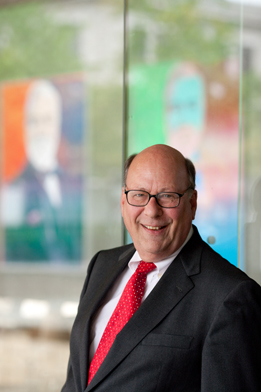 Spring 2011
Spring 2011|
“A definition of Carnegie Museums’ diversity as an institution is really the diversity of the people who work here. ” - David Hillenbrand
Photo: Joshua Franzos |
Outgoing Carnegie Museums President David Hillenbrand recollects what has made the past five years especially rich and memorable.This is an institution you serve, not run,” says David Hillenbrand, who ends his tenure as president of Carnegie Museums of Pittsburgh in early March. “It’s really a privilege, and one not many individuals get to experience.” To be exact, over its 116-year history, only eight people have led Carnegie Museums, Pittsburgh’s largest cultural organization. The ninth, John Wetenhall, who has a 20-year track record of managing museums, will begin his tenure on March 7.
When Hillenbrand joined the museums in May 2005, he was the first to say that he wasn’t a “museum guy.” Rather, he was a 28-year veteran of the global chemicals giant, Bayer, where, among his other posts, he served as president of Bayer Canada for eight years. He and his wife, Georgianna, had just begun an early retirement in Savannah, Georgia, when he was tapped to lead Carnegie Museums through the completion of an ambitious capital campaign and a period of aggressive physical growth. What he didn’t know then was that the institution would also face its share of financial turmoil brought on by the near collapse of the stock market in late 2008. The country’s economic roller-coaster ride took a gigantic bite out of the endowments of most non-profit organizations, and Carnegie Museums was no exception. “David was just the right leader at just the right time,” says Lee Foster, chairman of L.B. Foster Company and chair of the Carnegie Museums board of trustees. “He brought with him not only an incredibly strong track record of business management and visionary leadership, but also a personal passion for history, the arts, and science education. “Five and a half years later, we are without a doubt a much stronger organization thanks to David’s leadership,” Foster adds. “On behalf of the staff and volunteer leaders of Carnegie Museums of Pittsburgh, I’m proud to extend my thanks to David for his dedicated service and his friendship. Of course, we won’t be losing either, as we were wise enough to name David a Carnegie Museums Life Trustee.” During Hillenbrand’s tenure, Carnegie Museums completed its Building the Future campaign with $161 million in pledged gifts—$11 million above its goal. Museum projects completed during that time include Dinosaurs in Their Time, Highmark SportsWorks®, roboworld™, and the Ailsa Mellon Bruce Galleries of decorative arts. Another significant development, which Hillenbrand spearheaded, was the 2009 sale of three acres of land along Forbes Avenue to Carnegie Mellon University. The closing of the $23 million deal was not only a boon to Carnegie Museums financially, but the property’s planned development promises to create a much-anticipated economic, cultural, and educational gateway between Oakland and the Carnegie Mellon campus. Hillenbrand also found himself in the position of recruiting new leaders for Carnegie Museum of Natural History, Carnegie Museum of Art, and Carnegie Science Center—a tall order, but one he embraced. “The transition of leadership is a natural thing, and it always leads to new opportunities,” Hillenbrand says. “Our new leaders—including our new president—are an exceptional group of professionals who now have an opportunity to leave their own marks, as the leaders before them did, and that’s exciting.” Hillenbrand adds he’s especially proud that, strategically, the four Carnegie Museums are each on firm footing. “We’ve made great strides in setting our future course as a collection of four distinctive museums that also have the potential for even greater collaboration, which I know will be a focus of our new president.” When asked to recount what’s made his time at Carnegie Museums most memorable, in addition to the big achievements, Hillenbrand recounts his regular walks through the museums, exploring the “nooks and crannies”—particularly those in the historic Oakland facility, which is home to Carnegie Museums of Art and Natural History, Carnegie Music Hall, and the office of the president. “I have a master key that opens every locked door in this place,” he says, “so I’ve made it a habit to go around and explore as much as possible. There are all kinds of things that happen when you wander around—and there are often people associated with those discoveries, which is the best part.” Those people, Hillenbrand says, are not only what make the four Carnegie Museums tick but what make them great. “A definition of Carnegie Museums’ diversity as an institution is really the diversity of the people who work here,” he says. “The richness of the intellectual environment and commitment of our people are things that I’ve truly treasured—interacting with our curators, our scientists, our security guards, our skilled craftsmen, all of whom really care about our museums. They each invest so much into their work and are so passionate about what they do and what this institution does.” Hillenbrand plans to re-retire now, but he won’t be a stranger to Pittsburgh. He’ll be maintaining his Pittsburgh residence in addition to his strong connections to the region’s business and cultural communities, as he’ll continue to serve on the boards of Carnegie Museums, The Hillman Company, Hill House Association, and Koppers, for which he is also board chair. “I’ve personally gained a lot from my time in Pittsburgh and at Carnegie Museums,” Hillenbrand says, “and that’s what will stay with me.”
|
Reclaiming Paul Thek · Science for Life · Chasing Beauty · Setting Andy to Music · NewsWorthy · Face Time: Ragnar Kjartansson · Science & Nature: 100 Years of Homemade Lightning · Artistic License: Something to Believe In · The Big Picture
 |
Copyright © 2017 CARNEGIE Magazine. All rights reserved. |

